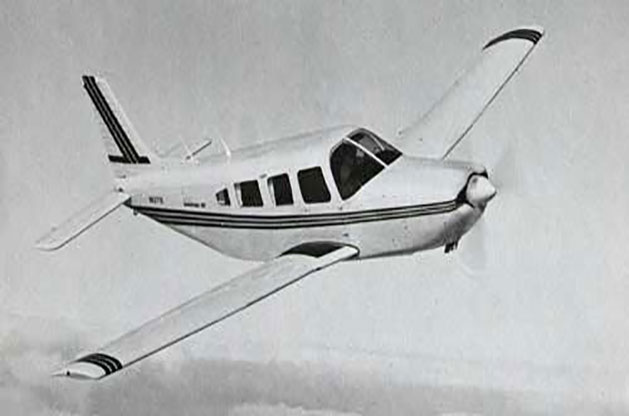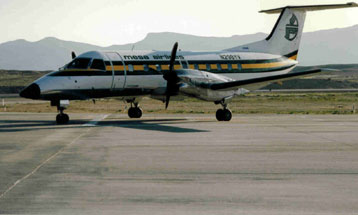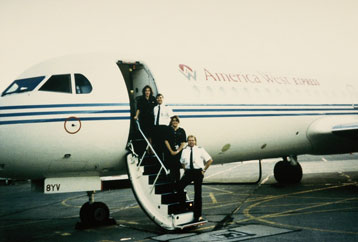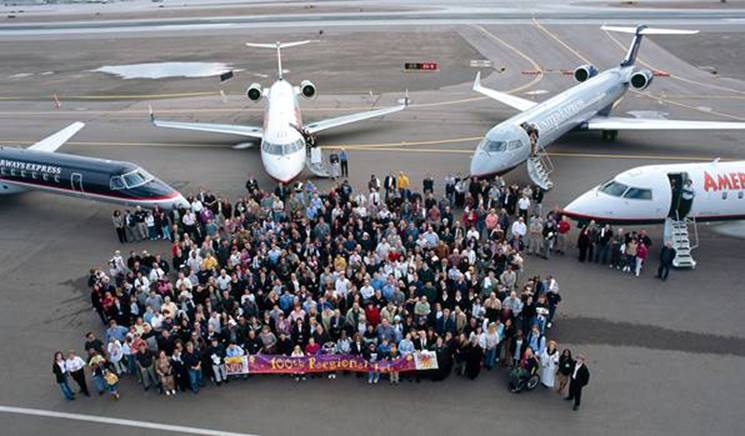Mesa Airlines...A Proud History, A Very Bright Future
1982
Mesa Airlines' story began near a windy mesa in the unassuming town of Farmington, New Mexico. The company's founders, Larry Risley (an A&P mechanic) and his wife Janie, mortgaged their house to pursue their dream of operating an airline. In 1982, "Mesa Air Shuttle" launched scheduled service between Farmington and Albuquerque with a five-seat Piper Saratoga aircraft. The call sign "Air Shuttle" is still in use today as a tribute to our earliest days. It was the beginning of what would become one of the industry's most successful regional airlines.
1983-1992

In
1983 the company tripled in size, with the addition of two aircraft -- as well as the first employee uniforms. In
1984, Mesa added its first twin-engine aircraft – a nine-passenger Chieftain, received its first Essential Air Service (EAS) contract, took delivery of its first 15-passenger Beechcraft 99 and later four Beechcraft 1900s. By
1987, Mesa expanded its fleet to 11 aircraft with 187 employees serving four states and had completed its Initial Public Offering
(IPO) of 865,000 shares of stock at $7.50, traded on the
NASDAQ Exchange under the symbol
“MESA.” In
1989, the company expanded through a codeshare agreement with
Midwest Express serving an extensive network of cities out of Milwaukee and in
1990, Mesa acquired
Aspen Airways providing a codeshare agreement with United Airlines to operate as United Express from Denver. With its unparalleled growth and success, the airline created its own flight training program,
Mesa Pilot Development, to ensure it consistently had a pool of qualified, well-trained pilots. This type of ingenuity and entrepreneurial spirit have been key to Mesa's success since day one. As the 80s came to an end, Mesa began what industry analysts called its "deal-a-year" growth.
 Acquisitions continued with the purchase of Air Midwest in 1991 (with its USAir Express codeshare agreement in Kansas City) and Mesa became the launch customer of the Beechcraft 1900D aircraft, adding 58 to its fleet. The company continued to expand its fleet with orders for 23 Embraer 120 aircraft.
Acquisitions continued with the purchase of Air Midwest in 1991 (with its USAir Express codeshare agreement in Kansas City) and Mesa became the launch customer of the Beechcraft 1900D aircraft, adding 58 to its fleet. The company continued to expand its fleet with orders for 23 Embraer 120 aircraft.
 In late 1991, Mesa commenced service as Florida Gulf Airlines with routes form Tampa under a US Air Express codeshare agreement. Mesa's stock price soared to $81 with $78 million in revenue. Very significantly, in 1992, Mesa entered a long-standing relationship with America West Airlines which would survive mergers with US
In late 1991, Mesa commenced service as Florida Gulf Airlines with routes form Tampa under a US Air Express codeshare agreement. Mesa's stock price soared to $81 with $78 million in revenue. Very significantly, in 1992, Mesa entered a long-standing relationship with America West Airlines which would survive mergers with US
Airways and, most recently, American Airlines. Mesa also acquired WestAir Commuter Airlines with its hubs in San Francisco, Los Angeles, Portland and Seattle and a codeshare with United Airlines.
In its first ten years of business, Mesa braved competition from six other carriers (none of which survived) as it slowly expanded service throughout New Mexico and grew from a company with one aircraft serving two cities to an organization operating 38 aircraft serving 63 cities. Key elements to Mesa's initial success remain core business principle today: The airline surpassed the competition and overcame fare wars between them by providing safe, reliable air service while maintaining an efficient low-cost structure.
1993-1998
In 1993, Mesa’s stock hit an all-time high of $108 and the Company was honored as Air Transport World’s 1992 Regional Airline of Year. In 1994, Pittsburgh-based Crown Airways was acquired, further strengthening Mesa's ties to US Airways and by 1995, 95 percent of Mesa's flying was derived from operations associated with codesharing agreements with United Airlines, USAir and America West Airlines. 1995 revenues exceeded half a billion dollars and Mesa employed more than 5,000 people. Despite challenging times in the industry, Larry Risley continued to lead the Company without a single furlough or employee wage reduction. Unfortunately, 1997 was a difficult year as Mesa's codeshare agreement with United ended and independent jet flying in Texas was proving unprofitable.

In early 1998, Jonathan Ornstein returned to the company and was appointed CEO of Mesa Air Group. (During his first tenure with Mesa, from 1988 to 1994, Ornstein worked closely with Larry and Janie, serving the Company in many roles ranging from ramp agent to EVP and President of wholly-owned subsidiary, WestAir Holding, Inc.) Larry Risley remained on Mesa's board of directors and over the next year, the new management team moved quickly to restore and expand Mesa's codeshare relationships as the foundation for renewed growth and profitability. Mesa negotiated a new codeshare agreement with America West, moved its headquarters from Farmington to Phoenix and expanded outside representation on its corporate board of directors. By the end of 1998, Mesa was operating 24 CRJ 200 aircraft, 12 Dash 8 aircraft and 79 Beech1900 D aircraft. Mesa’s quick return to growth and profitability made headlines in the industry.
1999-2007

In 1999, Mesa acquired Charlotte-based CCAir along with its US Airways routes and added 13 CRJ 200s bringing the fleet total to 32. The company also finalized negotiations with Embraer to add 36 ERJ 145 aircraft to its fleet and Professional Pilot Magazine recognized Mesa with its Pilot Management Teamwork Award for 1999. By 2000, Mesa’s plan was moving forward on every front. The America West codeshare grew from 17 to 22 regional jets and 75 percent of Mesa's flying was under revenue guarantee contracts. Mesa had reduced its unprofitable operations, including the removal of 17 19-seat turboprop aircraft from its fleet. USAir extended its contract with Mesa, adding 18 jets to the fleet, and a new codeshare with Midwest Express was announced. In 2000, the company appointed Michael Lotz President. In 2001, Mesa announced an agreement with America West to add up to 40 larger CRJ 700 and 900 aircraft and became the launch customer for the new 86-seat Bombardier CRJ 900. Also that year the company negotiated an agreement with Frontier to operate as Frontier JetExpress out of Denver.
Tragically, on September 11, 2001, the aviation industry came to an abrupt halt as world witnessed the most horrific attack on U.S. soil perpetrated through the use of civil aviation aircraft. Not immune to the downturn, Mesa was forced to furlough employees for the first time in its history. By 2002, dramatic cuts in capacity began to reverse as the nation showed its resiliency. Mesa announced the formation of Freedom Airlines to utilize its new CRJ900 aircraft, recalled all furloughed employees and added a new flight attendant contract. In 2003, as US Airways emerged from bankruptcy, scope restrictions were removed and Mesa negotiated a new pilot contract. Subsequently, Mesa re-established a codeshare agreement with United Airlines to operate as United Express.Though Mesa’s codeshare agreement with Frontier came to an end, the company negotiated a codeshare agreement with Delta Air Lines for Freedom Airlines to operate as a Delta Connection carrier.
 On September 22, 2004, Mesa suffered one of its greatest personal losses with the passing of founder Larry Risley at the age of 59. He was honored by the company with the re-numbering of company aircraft tail numbers to end in the letters “LR.” Many "LR" aircraft still operate in Mesa's fleet. In 2005, with revenues exceeding $1 billion, Mesa employed 4,400 people and operated a fleet of 180 aircraft as America West Express, US Airways Express, Midwest Express and as Mesa Airlines in New Mexico and Texas. In recognition of its success, the company was awarded the Air Transport World (ATW) Regional Airline of the Year Award a second time. The company celebrated the acquisition of its 100th regional jet.
On September 22, 2004, Mesa suffered one of its greatest personal losses with the passing of founder Larry Risley at the age of 59. He was honored by the company with the re-numbering of company aircraft tail numbers to end in the letters “LR.” Many "LR" aircraft still operate in Mesa's fleet. In 2005, with revenues exceeding $1 billion, Mesa employed 4,400 people and operated a fleet of 180 aircraft as America West Express, US Airways Express, Midwest Express and as Mesa Airlines in New Mexico and Texas. In recognition of its success, the company was awarded the Air Transport World (ATW) Regional Airline of the Year Award a second time. The company celebrated the acquisition of its 100th regional jet.
Mesa Airlines 25th Anniversary 1982-2007
In 2006, Mesa entered the inter-island market of the Hawaiian islands operating independently as go! Airlines with five CRJ-200 aircraft. The new endeavor brought expanded service and affordable fares to the people of the Hawaiian Islands. Mesa sought other opportunities abroad, researching a joint venture with Shenzhen Airlines in China while building its domestic position with the addition of 12 deHavilland Dash 8 aircraft to its Delta Connection fleet.
In 2007, the joint venture between Mesa Airlines and Shenzen became a reality with the start-up of Kungpeng Airlines. Back at home, Mesa added 14 CRJ-900 to its fleet and launched go! Express, a codeshare agreement with Mokulele Airlines. The company also celebrated its 25th Anniversary.
2008-2013
2008 was a challenging year due to the high cost of operating an aging fleet. Mesa ceased operations as Air Midwest and parked its Beechcraft 1900 aircraft. Simultaneously, Delta Air Lines attempted to terminate its ERJ-145 contract, though Mesa won a court injunction. In October 2008, industry veteran Paul Foley was appointed Mesa's Chief Operating Officer. In October 2009, go! airlines assumed the Hawaiian flying performed by Mokulele Airlines (by this time owned by Republic Airways Holdings’ Shuttle America) and its parent company. The combined operation was rebranded as go! Mokulele. In 2008, Mesa’s pilots ratified a new agreement and Kunpeng Airlines was sold.
In 2010, with fuel prices skyrocketing to more than $100 a barrel, Mesa experienced the most difficult period in its history and was forced to enter a reorganizational bankruptcy by its lenders. The company emerged from bankruptcy on March 1, 2011 (just 14 months later) as a privately-held company (recognized as the fastest and least impactful reorganization processes ever undertaken by an airline.) In the process, the company returned 100 excess 50-seat aircraft and drastically streamlined to focus on the operation of large regional jets. Though its fleet and workforce were dramatically reduced, the company honored its collective bargaining agreements, never furloughed a flight attendant and did not cut employee wages. During the process, Mesa sold its ownership in Spirit Airlines and settled its non-aircraft related debt.
A leaner and more efficient carrier, for four consecutive years (2010-2013) Mesa led the industry as the No. 1 regional airline for DOT statistics measuring the percentage of flights arriving on time and completion factor as well as the least passenger complaints and lost bags.
In September 2013, Mesa announced a new agreement with United Airlines to extend the term of its CRJ700 fleet to 2019 and add 30 new United-owned Embraer 175 aircraft to its fleet between June 2014 and July 2015. It signaled a huge vote of confidence from new United leadership and would mean the creation of 750 new jobs over a two-year period.
Mesa's maintenance team was recognized with the FAA's prestigious Employer’s Diamond Award for 2013.
2014
Mesa and United Airlines launch the E175
An additional boost to Mesa’s return to industry prominence came in February 2014 when the company announced an agreement with US Airways extending the contract on its 38 CRJ-900 aircraft and adding 4 additional CRJ-900s with an eight year term. In April 2014, after providing safe, reliable, low fare service to nearly five million go! passengers, Mesa ceased its Hawai'i service to focus on its mainline code share operations comprising 98 percent of its business.
In May 2014, the company further expanded its relationship with the new American Airlines (previously US Airways) by finalizing an agreement for the addition of 6 more CRJ 900 aircraft to its fleet. In June 2014, the company launched its inaugural E175 service for United Express from its new base at Houston’s George Bush Intercontinental Airport. In August 2014, the company closed on a $30 million line of credit as an important step in funding aircraft purchases and current and future growth plans.
2015
In January 2015, Mesa’s United Express fleet consisted of 20 CRJ700s and 18 175s (with 12 E-Jets still scheduled for delivery) and its American Eagle/US Airways fleet was comprised of 57 CRJ 900s. In 2015, Mesa consolidated its flying for American from bases in Dallas and Phoenix and for United from bases in Washington Dulles and Houston. These moves, and new maintenance bases in El Paso, and Midland, Texas further streamline its operations and support the company’s current and future growth plans.
In February 2015, Mesa announced an agreement to purchase seven new-from-the-factory Bombardier CRJ900 NextGen aircraft to operate for American Airlines. All aircraft were delivered in 2015, bringing Mesa's CRJ900 fleet total to 64. Not only was Mesa the launch customer of this fuel efficient, comfortable and consistently profitable regional jet in 2001, the company operates among the largest CRJ900 fleets in the world. The addition of these seven aircraft as well as previous E-175 deliveries brought Mesa's 2015 end-of-year fleet total to 115.
In October 2015, Mesa announced an agreement with United Airlines to add 15 more Embraer 175 aircraft to its United Express fleet. The agreement was later expanded to 18 aircraft. The company also announced the closing of its first-ever offering of Enhanced Equipment Trust Certificates ("EETC"), in December 2015, securing fixed rate financing for the acquisition of 10 of the new Embraer 175 aircraft. This was the first EETC issued by a regional airline, representing a major landmark for Mesa.
2016
In 2016, Mesa’s Maintenance and Engineering Department was awarded the Federal Aviation Administration’s prestigious Employer’s Diamond Award of Excellence for the fifth straight year.
The company also entered contract negotiations with the NavBlue corporation to replace the Sabre suite of operational software. Once implemented, NavBlue will provide the company the latest technology available in the industry. The contract was signed the end of 2016, and the company looks forward to a successful implementation, scheduled for May of 2018.
2017
In 2017, Mesa had a successful and exciting year. In February 2017, the company expanded its partnership with United Airlines, signing an agreement to add 12 additional Embraer 175 aircraft to the fleet. The delivery of the 12 additional aircraft created over 500 new career opportunities at Mesa, bringing total employee count to 3,100. By year-end, the company’s total Embraer 175 count was 60.
The company also reached new collective bargaining agreements with both the pilot and the flight attendant groups, building a strong foundation for the continued growth of the company. These agreements were monumental, as they solidify the relationship between management and the workforce, and help ensure a bright future for Mesa.
Mesa also opened its state-of-the-art training center in Phoenix, Arizona also gives the company the opportunity to provide new hires an exceptional training experience. The 23,000 square foot facility includes 14 classrooms with the capacity to train over 300 crew members at any given time. The new facility also boasts a full-size regional jet cabin featured in the lobby.
2018
In 2018, Mesa continued moving forward. In March the company announced a new career path program with United Airlines, which provides Mesa pilots with a clear path to United.
In August 2018, Mesa returned to the public market with a successful IPO, raising $112 million. The IPO was a key step in planning for Mesa’s long-term success.
2019
2019 was a big year for Mesa. In December we finalized a new contract with United Airlines, which calls for the addition of 20 new E175 aircraft in 2020. As part of the contract we the company will lease its aging CRJ-700s to another United Express carrier. In addition to the new United Express aircraft, the company signed a Memorandum of Understanding with Mitsubishi Aircraft Corporation for an order of 50 M100 SpaceJets as part of its long-term fleet replacement strategy.
The company also welcomed a number of new leaders, including Brad Rich, former United Airlines Senior Vice President of United Express and former President of SkyWest, Inc., as Executive Vice President and Chief Operating Officer; Brad Holt, former President of ExpressJet, as Senior Vice President of Flight Operations; Doug Shockey, former Chief Operating Officer and Vice President of Maintenance for Pinnacle Airlines, as Vice President of Maintenance; Billy Mostowy, previously Aviation Programs Manager for The Weather Company and former Director of Operational Control Center for SkyWest, as Senior Director of the SOC.
Since its modest beginnings in Farmington, New Mexico, Mesa continues to build on its proven track record of successful growth supported by safety-focused reliable operations and industry-leading cost
efficiency. The people of Mesa (long-time employees and new alike) are benefiting from the successful business model established by Larry Risley in 1982. With growth and advancement opportunities unparalleled in the regional industry, there has never been a better time to join Mesa Airlines!